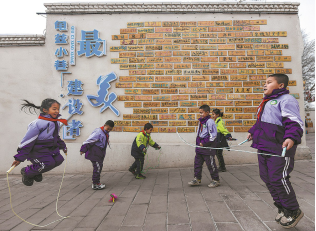
In Kuqa, Xinjiang, an elderly man named Abudulkadeer Memetmin runs a teahouse that has become a symbol of community warmth. Located in Qiuci Alley (巷), his teahouse offers simple pleasures. For just 2 to 5 yuan, visitors sip tea, play cards, and chat, creating a lively atmosphere that blends tradition with daily life. “People come here for the company, not just the tea,” says Abudulkadeer, who turned his home into the teahouse after retiring as a truck driver in 2021, following the local government’s renovation of the alley in 2023.
Qiuci Alley, once a place of rough roads and collapsing walls, has been transformed. The renovation project preserved its original buildings while improving water, electricity, and road conditions. Over 4,000 residents volunteered to clear debris, decorate with antiques, and restore the alley’s charm. Now, the 1.2-kilometer street dazzles with brightly colorful doors, diamond-shaped lattice windows, ancient courtyards, and roadside flowers, drawing visitors to its blend of Qing Dynasty and Republic of China architecture.
The transformation has boosted tourism significantly. With 32 million yuan invested, the alley now hosts 55 businesses — from snack stalls to intangible cultural heritage studios. More than 1.55 million tourists have visited, creating 360 jobs and generating 210 million yuan in revenue. Wang Xinyu, who opened a café named after her dog, says the alley’s ethnic-style buildings and murals attract travelers seeking an authentic experience.
Women in the area have also gained new opportunities. A workshop supports female entrepreneurs, like tailor Nurgul Memet, whose income doubled after moving her shop to the alley. She teaches local women to craft dresses and bags from Atlas silk, allowing them to earn up to 5,000 yuan monthly. Ma Xiaoyan, an intangible cultural heritage enthusiast, runs a studio where visitors learn traditional crafts, blending Xinjiang’s traditional culture with modern designs.
Today, Qiuci Alley stands as a testament to how tradition and modernity can thrive together. Its carved doors, historical homes, and vibrant murals not only preserve cultural heritage but also breathe new life into the community. As Abudulkadeer notes, the alley now buzzes with locals and tourists alike, proving that small changes can create big wonders in preserving both culture and community spirit.
原创编写 版权所有 侵权必究! 每日更新 个性化阅读 英语飙升!
1.1. Why does the author mention Abudulkadeer Memetmin?
A To introduce the teahouse’s history.
B To show the alley’s old traditions.
C To lead in the community’s story.
D To describe a retired driver’s life.
解析:选C。C 推理判断题。作者通过 Abudulkadeer的茶馆引出社区温暖的主题,后文围绕龟兹巷改造和社区活力展开,因此提到他的目的是“引出社区的故事”。故选C。
2.2. What does the underlined word “dazzles” mean?
A Shines brightly.
B Confuses visitors.
C Changes gradually.
D Disappears slowly.
解析:选A。A 词义猜测题。根据第二段划线单词后文提到“brightly colorful doors, diamond-shaped lattice windows, ancient courtyards, and roadside flowers”色彩鲜艳的门,菱形的格子窗,古老的庭院,路边的鲜花。由此可见,改造后的街道因色彩斑斓的门窗和花径而“闪耀”,“dazzles”意为“光彩夺目”,与A选项“Shines brightly”同义。故选A。
3.3. What do the statistics in Paragraph 3 show?
A The cultural heritage preservation efforts.
B The tourism growth after renovation.
C The residents’ volunteer contributions.
D The challenges of modernization.
解析:选B。B 推理判断题。第三段中的数据(3200万元投资、55家商户、155万游客、360个工作岗位、2.1亿元收入)均属于“社区改造后旅游业的显著增长”。故选B。
4.4. What does the fourth paragraph focus on?
A Women’s entrepreneurial opportunities.
B Traditional craft studios’ designs.
C The role of intangible heritage.
D Atlas silk production methods.
解析:选A。A 段落大意题。第四段以裁缝Nurgul Memet和非遗爱好者马晓燕为例,强调女性通过工作室创业、增收,核心点是“女性获得的创业新机遇”。故选A。
